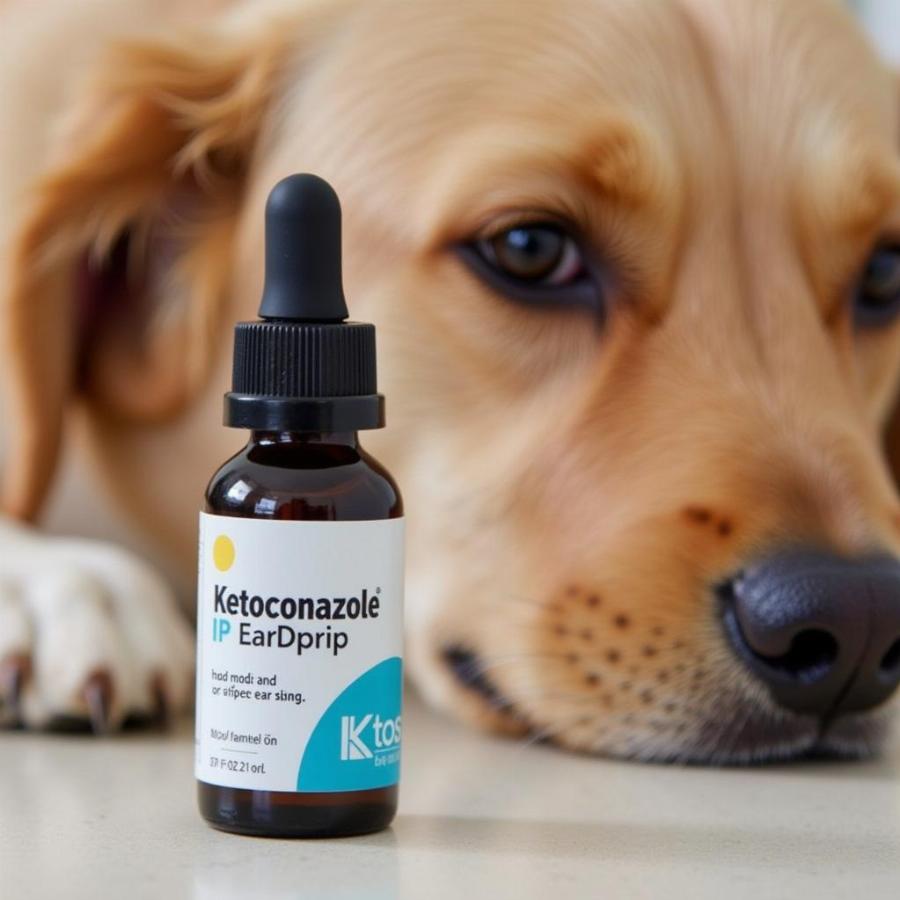Ketoconazole for dogs ears is a common treatment for fungal and yeast infections, offering relief from itching, redness, and discomfort. Understanding how and when to use this medication is crucial for effectively treating your furry friend’s ear problems. This guide will delve into the uses, benefits, and potential risks of ketoconazole for dogs’ ears, equipping you with the knowledge to provide the best possible care for your canine companion.
Understanding Ketoconazole: What It Is and How It Works
Ketoconazole is an antifungal medication that works by disrupting the growth of fungi and yeast. It’s often prescribed for various skin and ear infections in dogs, particularly those caused by Malassezia pachydermatis, a yeast commonly found on dog skin. This medication comes in several forms, including creams, ointments, shampoos, and oral tablets. When used for ear infections, it’s typically found in ear drops or as a component of medicated ear cleaners.
 Ketoconazole Ear Drops for Dogs
Ketoconazole Ear Drops for Dogs
How does ketoconazole work in the ears? Ketoconazole inhibits the production of ergosterol, a crucial component of fungal cell membranes. This disruption weakens the cell walls, ultimately leading to the death of the fungus.
When is Ketoconazole Prescribed for Dog Ears?
Ketoconazole is usually prescribed when a dog exhibits symptoms of a fungal or yeast ear infection. These symptoms can include:
- Head shaking: Excessive head shaking is often the first sign of ear discomfort.
- Scratching at ears: Constant scratching or pawing at the ears indicates itching and irritation.
- Redness and inflammation: The ear canal may appear red, swollen, and inflamed.
- Discharge: A yellowish-brown or dark-colored discharge with a foul odor is characteristic of yeast infections.
- Waxy buildup: Excessive earwax can be a sign of infection.
It’s important to note that these symptoms can also be indicative of other ear problems, such as bacterial infections or ear mites. Therefore, a proper diagnosis from a veterinarian is crucial before starting any treatment with ketoconazole.
Administering Ketoconazole Ear Drops/Cleaner: A Step-by-Step Guide
If your vet prescribes ketoconazole ear drops or cleaner, follow these steps for safe and effective administration:
- Clean the ear: Gently clean your dog’s ear canal with a veterinarian-approved ear cleaning solution to remove any debris or discharge.
- Apply the medication: Follow your veterinarian’s instructions regarding the dosage and frequency of application.
- Massage the ear base: Gently massage the base of the ear to ensure the medication distributes evenly throughout the ear canal.
- Prevent head shaking: Try to prevent your dog from shaking its head immediately after application to allow the medication to work effectively.
Potential Side Effects and Precautions
While generally safe, ketoconazole can occasionally cause side effects in some dogs. These may include:
- Local irritation: Redness, itching, or swelling at the application site.
- Hearing loss (rare): This is usually temporary and resolves after discontinuing the medication.
- Changes in skin pigmentation: In rare cases, ketoconazole can cause temporary changes in skin color.
If you notice any unusual side effects, contact your veterinarian immediately. Also, inform your vet about any other medications your dog is taking, as there may be potential drug interactions.
Ketoconazole vs. Other Ear Infection Treatments
Ketoconazole is often compared to other antifungal and antibacterial medications for ear infections, such as antifungal shampoo for dog or chlorhexidine shampoo for dogs. While all these medications aim to treat ear infections, they target different types of pathogens. For example, best ear cleaner for dogs with yeast infection might contain different active ingredients and be more suited for yeast infections, while antibacterial shampoo dogs or medicated shampoos dog might be better suited to bacterial infections of the skin that may be contributing to or exacerbating ear problems. Your veterinarian can help you determine the best treatment option based on your dog’s specific condition.
Conclusion
Ketoconazole can be a highly effective treatment for fungal and yeast ear infections in dogs. By understanding how it works, when it’s prescribed, and how to administer it correctly, you can help your furry friend find relief from the discomfort of ear infections. Remember, a proper diagnosis from a veterinarian is essential before starting any treatment with ketoconazole.
FAQ
- How long does it take for ketoconazole to work for dog ears? Improvement is usually seen within a few days to a week.
- Can I use human ketoconazole on my dog? No, never use human medications on your dog without consulting a veterinarian.
- What happens if my dog licks the ketoconazole ear drops? While small amounts are unlikely to cause serious harm, contact your vet if your dog ingests a significant amount.
- Can ketoconazole be used with other ear medications? Discuss any other medications your dog is taking with your vet to avoid potential interactions.
- Are there natural alternatives to ketoconazole for dog ear infections? Some natural remedies may offer supportive care, but always consult with your vet before using them.
- How can I prevent ear infections in my dog? Regular ear cleaning and proper grooming can help prevent infections.
- What should I do if my dog’s ear infection doesn’t improve with ketoconazole? Consult your veterinarian, who may need to explore other treatment options.